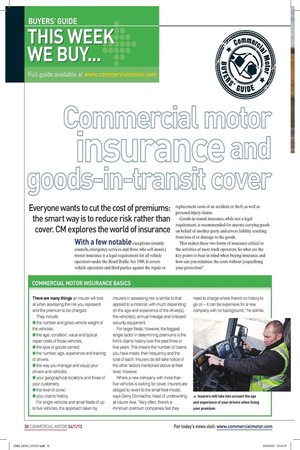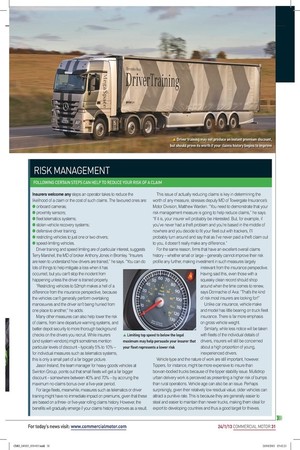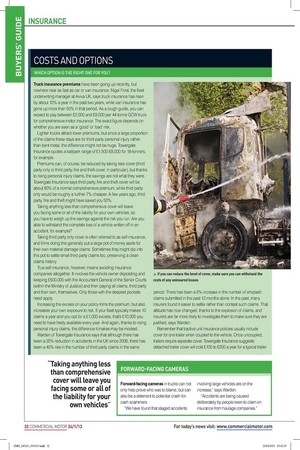IMCE CIREUFERE dzi=hi=iiRr rran'IR End
Page 24

Page 25

Page 26

Page 27

If you've noticed an error in this article please click here to report it so we can fix it.
Everyone wants to cut the cost of premiums: the smart way is to reduce risk rather than cover. CM explores the world of insurance With a few notable exceptions (mainly councils, emergency services and those who self-insure) motor insurance is a legal requirement for all vehicle operators under the Road Traffic Act 1988. It covers vehicle operators and third parties against the repair or replacement costs of an accident or theft, as well as personal injury claims.
Goods-in-transit insurance, while not a legal requirement, is recommended for anyone carrying goods on behalf of another party and covers liability resulting from loss of or damage to the goods.
That makes these two forms of insurance critical to the activities of most truck operators. So what are the key points to bear in mind when buying insurance and how can you minimise the costs without jeopardising your protection?
COMMERCIAL MOTOR INSURANCE BASICS There are many things an insurer will look at when assessing the risk you represent and the premium to be charged.
They include: • the number and gross vehicle weight of the vehicles; • the age, condition, value and typical repair costs of those vehicles; • the type of goods carried; • the number, age, experience and training of drivers; • the way you manage and equip your drivers and vehicles; • your geographical locations and those of your customers; • the level of cover; • your claims history.
For single vehicles and small fleets of up to five vehicles, the approach taken by insurers in assessing risk is similar to that applied to a motorist, with much depending on the age and experience of the driver(s), the vehicle(s), annual mileage and onboard security equipment.
For larger fleets, however, the biggest single factor in determining premiums is the firm's claims history over the past three or five years. This means the number of claims you have made, their frequency and the cost of each. Insurers do still take notice of the other factors mentioned above at fleet level, however.
Where a new company with more than five vehicles is looking for cover, insurers are obliged to revert to the small fleet model, says Gerry Donnachie, head of underwriting at insurer Axa. "Very often, there's a minimum premium companies feel they need to charge where there's no history to go on — it can be expensive for a new company with no background," he admits.
RISK MANAGEMENT FOLLOWING CERTAIN STEPS CAN HELP TO REDUCE YOUR RISK OF A CLAIM Insurers welcome any steps an operator takes to reduce the likelihood of a claim or the cost of such claims. The favoured ones are: • onboard cameras; • proximity sensors; • fleet telematics systems; • stolen-vehicle recovery systems; • defensive driver training; • restricting vehicles to just one or two drivers; • speed-limiting vehicles.
Driver training and speed limiting are of particular interest, suggests Terry Marshell, the MD of broker Anthony Jones in Bromley. "Insurers are keen to understand how drivers are trained," he says. "You can do lots of things to help mitigate a loss when it has occurred, but you can't stop the incident from happening unless the driver is trained properly.
"Restricting vehicles to 52mph makes a hell of a difference from the insurance perspective, because the vehicles can't generally perform overtaking manoeuvres and the driver isn't being hurried from one place to another," he adds.
Many other measures can also help lower the risk of claims, from lane departure warning systems, and better depot security to more thorough background checks on the drivers you recruit. While insurers (and system vendors) might sometimes mention particular levels of discount — typically 5% to 10% — for individual measures such as telematics systems, this is only a small part of a far bigger picture.
Jason Ireland, the team manager for heavy goods vehicles at Swinton Group, points out that small fleets will get a far bigger discount — somewhere between 40% and 70% — by accruing the maximum no-claims bonus over a five-year period.
For large fleets, meanwhile, measures such as telematics or driver training might have no immediate impact on premiums, given that these are based on a threeor five-year rolling claims history. However, the benefits will gradually emerge if your claims history improves as a result.
This issue of actually reducing claims is key in determining the worth of any measure, stresses deputy MD of Towergate Insurance's Motor Division, Matthew Warden. "You need to demonstrate that your risk management measure is going to help reduce claims," he says. "If it is, your insurer will probably be interested. But, for example, if you've never had a theft problem and you're based in the middle of nowhere and you decide to fit your fleet out with trackers, I'll probably turn around and say that as I've never paid a theft claim out to you, it doesn't really make any difference."
Unlike car insurance, vehicle make and model has little bearing on truck fleet insurance. There is far more emphasis on gross vehicle weight.
Similarly, while less notice will be taken with fleets of the individual details of drivers, insurers will still be concerned about a high proportion of young, inexperienced drivers.
Vehicle type and the nature of work are still important, however. Tippers, for instance, might be more expensive to insure than boxvan-bodied trucks because of the tipper stability issue. Multidrop urban delivery work is perceived as presenting a higher risk of bumps than rural operations. Vehicle age can also be an issue. Perhaps surprisingly, given their relatively low residual value, older vehicles can attract a punitive rate. This is because they are generally easier to steal and easier to maintain than newer trucks, making them ideal for export to developing countries and thus a good target for thieves.
COSTS AND OPTIONS WHICH OPTION IS THE RIGHT ONE FOR YOU?
Truck insurance premiums have been going up recently, but nowhere near as fast as car or van insurance. Nigel Frost, the fleet underwriting manager at Aviva UK, says truck insurance has risen by about 10% a year in the past two years, while van insurance has gone up more than 50% in that period. As a rough guide, you can expect to pay between £2,000 and £9,000 per 44-tonne GCW truck for comprehensive motor insurance. The exact figure depends on whether you are seen as a 'good' or 'bad' risk.
Lighter trucks attract lower premiums, but since a large proportion of the claims these days are for third-party personal injury rather than bent metal, the difference might not be huge. Towergate Insurance quotes a ballpark range of £1,500-£8,000 for 18-tonners, for example.
Premiums can, of course, be reduced by taking less cover (third party only or third party, fire and theft cover, in particular), but thanks to rising personal injury claims, the savings are not what they were. Towergate Insurance says third party, fire and theft cover will be about 80% of a normal comprehensive premium, while third party only would be roughly a further 7% cheaper. A few years ago, third party, fire and theft might have saved you 50%.
Taking anything less than comprehensive cover will leave you facing some or all of the liability for your own vehicles, so you have to weigh up the savings against the risk you run. Are you able to withstand the complete loss of a vehicle written off in an accident, for example?
Taking third party only cover is often referred to as self-insurance, and firms doing this generally put a large pot of money aside for their own material damage claims. Sometimes they might dip into this pot to settle small third party claims too, preserving a clean claims history.
True self-insurance, however, means avoiding insurance companies altogether. It involves the vehicle owner depositing and keeping £500,000 with the Accountant General of the Senior Courts (within the Ministry of Justice) and then paying all claims, third party and their own, themselves. Only those with the deepest pockets need apply.
Increasing the excess on your policy trims the premium, but also increases your own exposure to risk. If your fleet typically makes 10 claims a year and you opt for a £1,000 excess, that's £10,000 you need to have freely available every year. And again, thanks to rising personal injury claims, the difference it makes may be modest.
Warden of Towergate Insurance says that although there has been a 20% reduction in accidents in the UK since 2006, there has been a 40% rise in the number of third party claims in the same period. There has been a 6% increase in the number of whiplash claims submitted in the past 12 months alone. In the past, many insurers found it easier to settle rather than contest such claims. That attitude has now changed, thanks to the explosion of claims, and insurers are far more likely to investigate them to make sure they are justified, says Warden.
Remember that tractive unit insurance policies usually include cover for one trailer when coupled to the vehicle. Once uncoupled, trailers require separate cover. Towergate Insurance suggests detached trailer cover will cost £100 to £200 a year for a typical trailer.
FORWARD-FACING CAMERAS Forward-facing cameras in trucks can not only help prove who was to blame, but can also be a deterrent to potential crash-forcash scammers.
"We have found that staged accidents involving large vehicles are on the increase," says Warden.
"Accidents are being caused deliberately by people keen to claim on insurance from haulage companies."
CHOOSING YOUR SUPPLIERS It's advisable to find an experienced broker who truly understands the CV business. Remember, a broker will need all kinds of information about your business if they are to secure appropriate cover, so it is essential that you're honest with them, explaining what you do and how you do it, particularly if you have taken steps to manage your risks. When it comes to making a claim, a broker who understands the nature of goods vehicle operation —the blind spots around a truck, for example — is far more likely to be able to argue your case with third parties than one who does not.
Trade associations such as the Freight Transport Association and Road Haulage Association also offer their own branded insurance cover for their members, provided by a specialist broker. So that is one way of ensuring you deal with people who understand the industry.
Marshell of Anthony Jones warns that using a cheap online broker might not provide the best solution because their quote 'engines' are not always smart enough. "It is essential that anyone in this sector speaks to a broker," he says. "The matrix is there with all these online engines, but none of them is sophisticated enough to look at all the variables."
If your broker is good, stick with them. A good broker will always be willing to work with you to help you reduce your costs and find the best cover. Brokers have access to the same range of insurers, so there is no fundamental reason to switch broker to shop around.
Brokers and insurers will like you even more if you buy multiple insurance policies from them. Sourcing motor insurance, goods-in-transit, public liability or employer's liability cover from a single supplier should justify keen pricing.
Be careful about locking yourself in, and routinely test rates on the wider market.
Goods-in-transit policies are designed to cover your liability for stolen, destroyed or damaged goods. If you operate under standard RHA conditions with a liability of £1,300/tonne, that's the level of cover you need, irrespective of the actual value of the goods.
When it comes to the goods in your trucks, insurers and brokers will look at many of the same things as for motor insurance when fixing premiums — routes, the value of the goods, and claims history. Additional considerations, such as overnight parking arrangements, for example, might apply. Whatever level of cover you arrange, there will be some exemptions and restrictions. High-value, theftattractive loads, for instance, usually come with a payout cap (the 'inner limit') that can be considerably below the total value of goods. Drivers' personal effects are unlikely to be included as standard.
Loading and unloading operations are usually included under goods-in-transit cover, but make sure you know what is meant by this. A lift truck placing a load on a trailer will qualify as part of the loading operation, but that same lift truck crossing the yard with the same pallet 10 seconds earlier might not. Much depends on exactly where the vehicle operator's contractual liability starts and ends.
Restrictions might also apply to overnight arrangements: some policies will insist that overnight stops are only in secure parking facilities; others might require loads to remain 'attended' at all times. Take care to clarify such terms, making sure you understand the definition of a secure lorry park, for example.
The biggest mistake people make with goods-in-transit insurance is to agree to extend their liability for goods with a customer beyond that covered by their insurance, says Warden of Towergate Insurance.
"If you amend your conditions for a customer, perhaps because of commercial pressures, and don't keep your insurer aware, and there is a claim, they may well turn around and say they're not paying," he warns.
In terms of cost, goods-in-transit insurance premiums have fallen in recent years, thanks to growing levels of competition —Jonathan Eaton, head of marine at Aviva UK, says premiums have fallen by about 10% a year in the past couple of years. Towergate Insurance quotes a typical starting point for a business with a turnover of £100,000 operating a standard 44-tonne artic in the UK under RHA liability (£1 ,300/tonne) of £265 a year, rising to £530 a year for cover of £5,000/tonne.
Goods-in-transit policies can be amended in many ways, including extensions for particular loads or situations (an inability to use a trailer as a result of damage from goods, for instance) and the bolting-on of other, normally separate forms of insurance — public liability and employer's liability, for example. Tacking on combined public liability (to £5m) and employer's liability (to £10m) cover would cost just over £210 in the scenario quoted above, says Towergate Insurance.










































